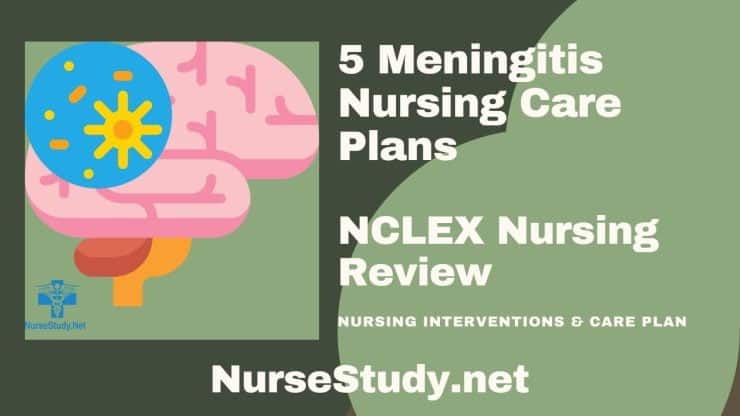Meningitis is a serious inflammatory condition affecting the meninges – the protective membranes surrounding the brain and spinal cord. This comprehensive guide covers essential nursing diagnoses and evidence-based care plans for managing patients with meningitis.
Understanding Meningitis
Meningitis can be caused by bacterial, viral, or fungal infections. The condition requires immediate medical attention due to its potentially life-threatening nature. Common transmission routes include:
- Respiratory droplets
- Direct contact with infected individuals
- Hematogenous spread
- Direct extension from adjacent infected structures
Risk Factors
- Age extremes (very young and elderly)
- Immunocompromised status
- Living in communal settings
- Recent neurosurgery
- Unvaccinated status
- Chronic medical conditions
Clinical Manifestations
- Severe headache
- Neck stiffness and pain
- Photophobia
- High fever
- Altered mental status
- Nausea and vomiting
- Kernig’s and Brudzinski’s signs
- Seizures in severe cases
Nursing Process
The nursing process for meningitis patients focuses on early recognition, prevention of complications, and supportive care. Critical aspects include:
- Neurological assessment
- Vital signs monitoring
- Infection control measures
- Pain management
- Prevention of complications
Essential Nursing Care Plans
1. Risk for Ineffective Cerebral Tissue Perfusion
Nursing Diagnosis: Risk for ineffective cerebral tissue perfusion related to the inflammatory process and increased intracranial pressure.
Related Factors:
- Meningeal inflammation
- Cerebral edema
- Altered cerebral blood flow
- Increased intracranial pressure
Nursing Interventions and Rationales:
Monitor neurological status q2-4h
- Enables early detection of deterioration
Maintain head elevation at 30-45 degrees
- Promotes venous drainage and reduces ICP
Monitor vital signs, especially blood pressure and pulse
- Identifies early signs of increasing ICP
Assess pupillary responses and level of consciousness
- Indicates changes in neurological status
Implement seizure precautions
- Prevents injury during potential seizure activity
Desired Outcomes:
- Patient maintains stable neurological status
- ICP remains within normal limits
- No signs of neurological deterioration
2. Hyperthermia
Nursing Diagnosis: Hyperthermia related to inflammatory process and infection.
Related Factors:
- Infectious process
- Inflammatory response
- Metabolic rate increase
- Dehydration
Nursing Interventions and Rationales:
Monitor temperature q2-4h
- Tracks fever progression and response to interventions
Administer antipyretics as ordered
- Reduces fever and associated discomfort
Apply cooling measures
- Assists in temperature reduction
Monitor fluid intake and output
- Prevents dehydration
Assess skin color and condition
- Identifies complications of hyperthermia
Desired Outcomes:
- Temperature maintains within normal range
- The patient remains adequately hydrated
- No signs of heat-related complications
3. Acute Pain
Nursing Diagnosis: Acute pain related to meningeal inflammation and increased intracranial pressure.
Related Factors:
- Meningeal irritation
- Increased ICP
- Inflammatory process
- Central nervous system infection
Nursing Interventions and Rationales:
Assess pain characteristics regularly
- Determines effectiveness of interventions
Administer analgesics as prescribed
- Provides pain relief
Minimize environmental stimuli
- Reduces aggravation of symptoms
Position patient for comfort
- Promotes comfort and reduces pain
Document pain patterns and response to interventions
- Enables evaluation of treatment effectiveness
Desired Outcomes:
- Pain levels decrease to manageable levels
- The patient demonstrates improved comfort
- The patient can participate in daily activities
4. Risk for Infection Transmission
Nursing Diagnosis: Risk for infection transmission related to exposure to pathogenic organisms.
Related Factors:
- Presence of infectious agents
- Close contact with others
- Compromised host defenses
- Invasive procedures
Nursing Interventions and Rationales:
Implement appropriate isolation precautions
- Prevents disease transmission
Use personal protective equipment
- Protects healthcare workers and visitors
Educate visitors about infection control measures
- Ensures compliance with precautions
Monitor for signs of secondary infection
- Enables early intervention
Administer antimicrobial therapy as prescribed
- Treats underlying infection
Desired Outcomes:
- No transmission to others
- The patient shows signs of infection resolution
- Compliance with infection control measures
5. Anxiety
Nursing Diagnosis: Anxiety related to acute illness and uncertain prognosis.
Related Factors:
- Threat to health status
- Fear of complications
- Unfamiliar environment
- Separation from a support system
Nursing Interventions and Rationales:
Assess anxiety level and coping mechanisms
- Determines appropriate interventions
Provide clear information about condition and procedures
- Reduces fear of unknown
Allow family presence when appropriate
- Provides emotional support
Maintain calm environment
- Reduces stress and anxiety
Listen to patient’s concerns
- Shows support and builds trust
Desired Outcomes:
- Decreased anxiety levels
- Improved coping mechanisms
- Better understanding of the condition
References
- Ackley, B. J., Ladwig, G. B., Makic, M. B., Martinez-Kratz, M. R., & Zanotti, M. (2023). Nursing diagnoses handbook: An evidence-based guide to planning care. St. Louis, MO: Elsevier.
- Archibald LK, Quisling RG. Central Nervous System Infections. Textbook of Neurointensive Care. 2013 May 7:427–517. doi: 10.1007/978-1-4471-5226-2_22. PMCID: PMC7122753.
- Ashwal, S. (1995). Neurologic Evaluation of the Patient With Acute Bacterial Meningitis. Neurologic Clinics, 13(3), 549-577. https://doi.org/10.1016/S0733-8619(18)30034-3
- Harding, M. M., Kwong, J., & Hagler, D. (2022). Lewis’s Medical-Surgical Nursing: Assessment and Management of Clinical Problems, Single Volume. Elsevier.
- Herdman, T. H., Kamitsuru, S., & Lopes, C. (2024). NANDA International Nursing Diagnoses – Definitions and Classification, 2024-2026.
- Hersi K, Gonzalez FJ, Kondamudi NP, et al. Meningitis (Nursing) [Updated 2023 Aug 12]. In: StatPearls [Internet]. Treasure Island (FL): StatPearls Publishing; 2024 Jan-. Available from: https://www.ncbi.nlm.nih.gov/books/NBK568762/
- Ignatavicius, D. D., Rebar, C., & Heimgartner, N. M. (2023). Medical-Surgical Nursing: Concepts for Clinical Judgment and Collaborative Care. Elsevier.
- Silvestri, L. A. (2023). Saunders comprehensive review for the NCLEX-RN examination. St. Louis, MO: Elsevier.
